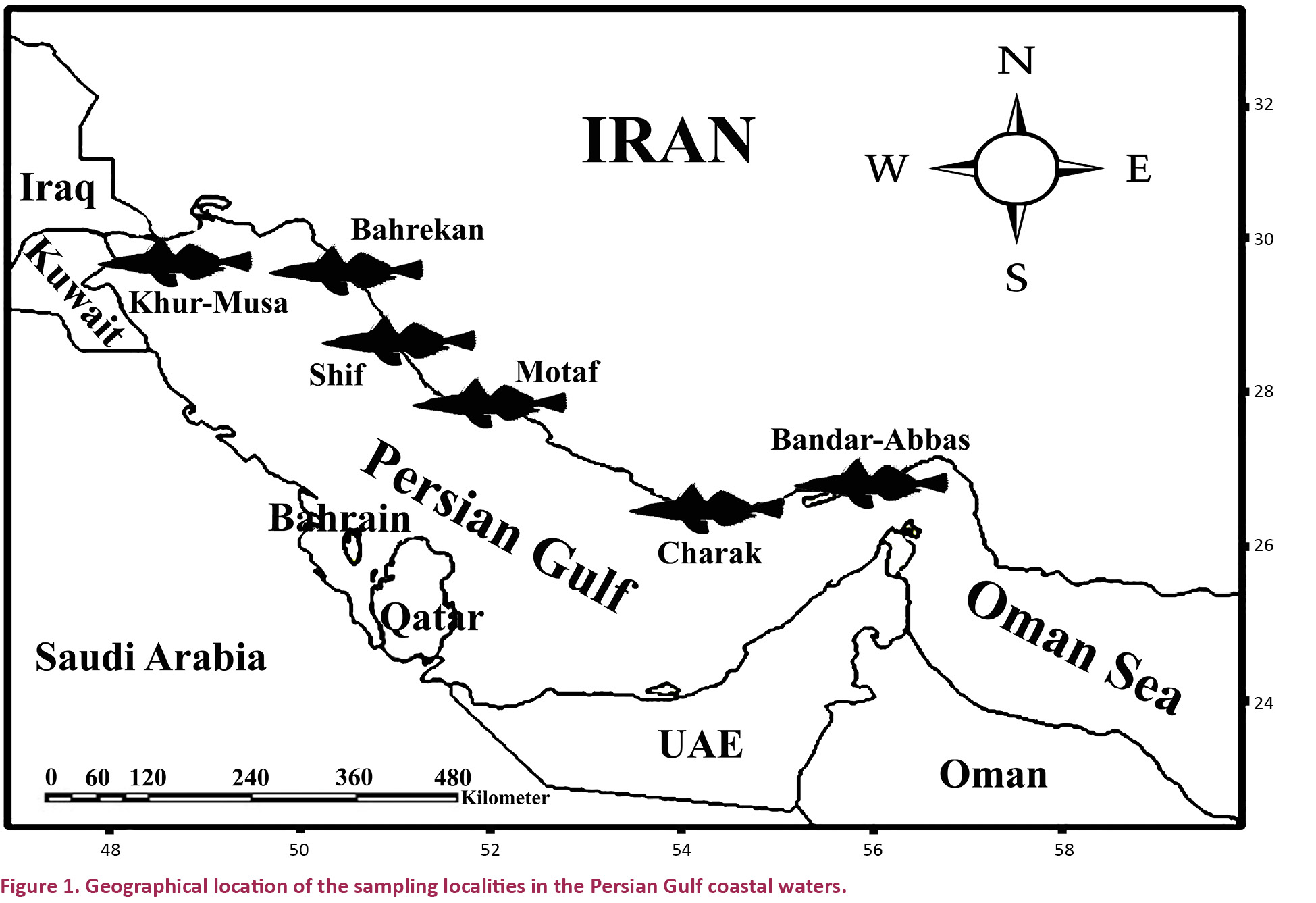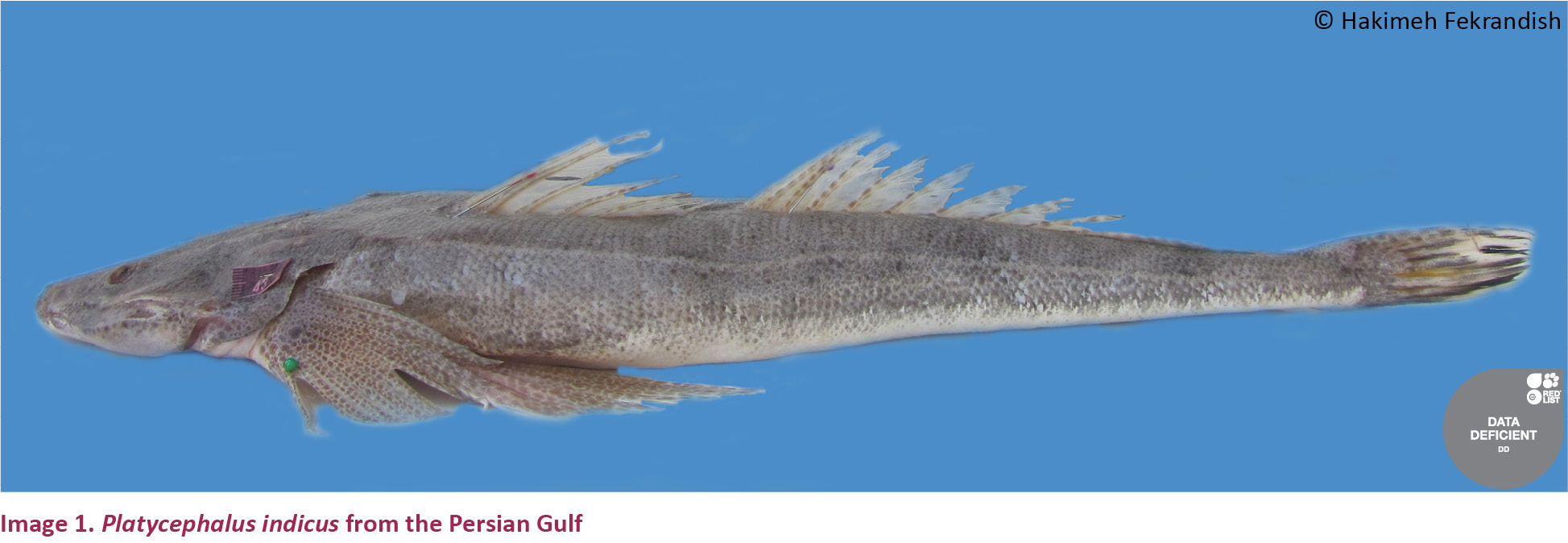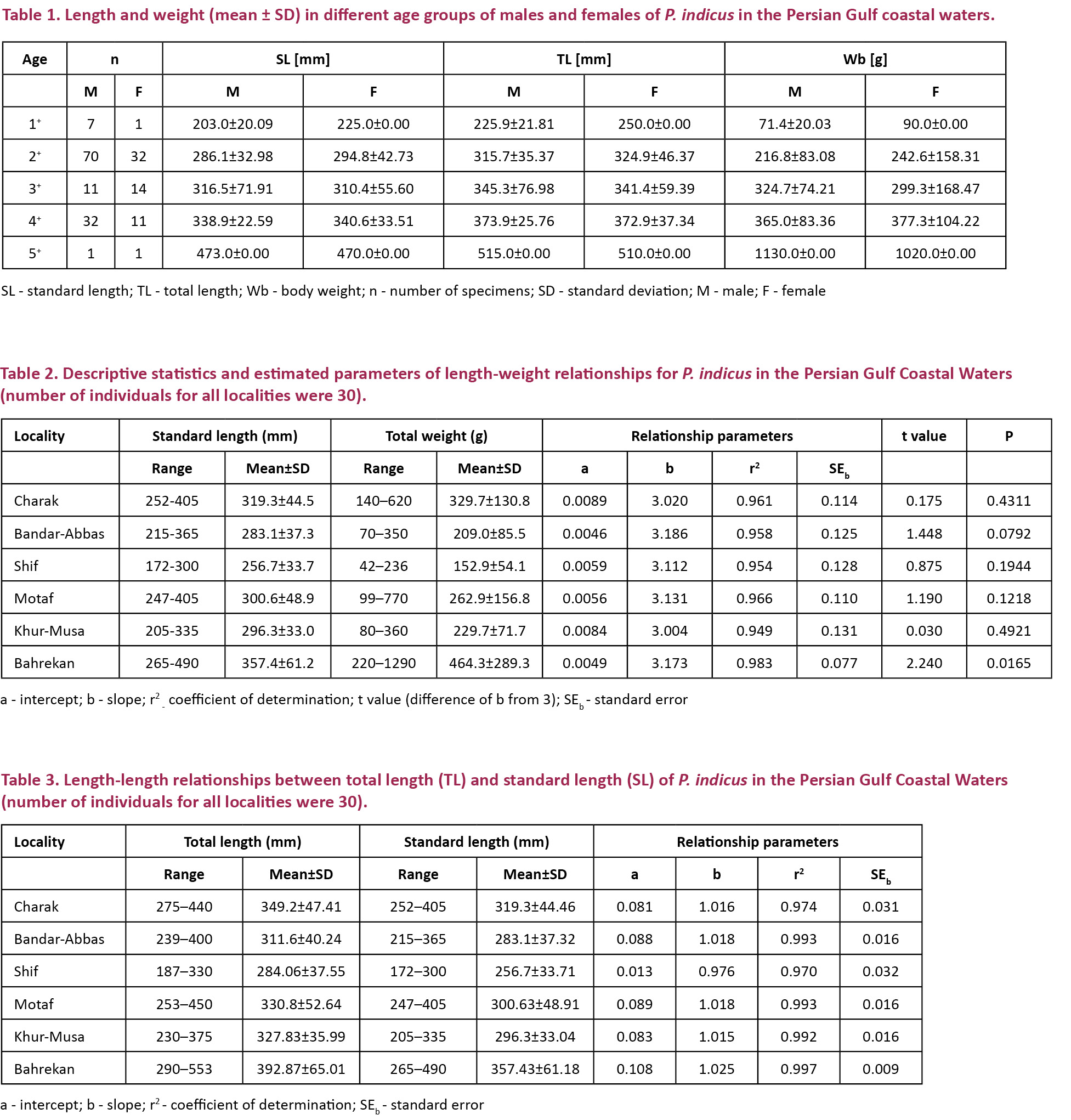Short Communication
Population structure, length-weight and length-length relationships of six populations of the Bartail Flathead Platycephalus indicus (Scorpaeniformes: Platycephalidae) along the Persian Gulf coastal waters
Hamed Mousavi-Sabet 1, Adeleh Heidari 2 & Hakimeh Fekrandish 3
1 Department of Fisheries, Faculty of Natural Resources, University of Guilan, Sowmeh Sara, P.O. Box: 1144, Guilan, Iran
2 Department of Fisheries, Bushehr Branch, Islamic Azad University, Bushehr, Iran
1 mousavi-sabet@guilan.ac.ir (corresponding author), 2 adeleheidari14@yahoo.com, 3 hfekrandish@yahoo.com
Abstract: The size frequency distribution for age structure, length-weight (LWR) and length-length (LLR) relationships of six populations of Platycephalus indicus along the Persian Gulf coastal waters in Iran are reported. A total of 180 P. indicus specimens were studied from six localities including Charak, Bandar-Abbas, Shif, Motaf, Khur-Musa and Bahrekan. The maximum standard length recorded for the studied populations ranged between 300 to 510 mm and the b values of the length-weight relationships ranged between 3.0 and 3.2. The obtained results indicated isometric growth patterns for all these populations with the exception of the Bahrekan population which showed a positive allometric growth pattern. The LLR between the total and standard lengths in these populations were found to be highly significant. The results would be useful for further studies on population assessment and sustainable conservation of the fish along the Persian Gulf coastal waters.
Keywords: Bushehr Province, flathead fish, growth patterns, Iran.
doi: http://dx.doi.org/10.11609/JoTT.o3738.6810-4 | ZooBank: urn:lsid:zoobank.org:pub:B73A4469-76E1-41A3-B509-F05CBDBE75E4
Editor: Neelesh Dahanukar, IISER, Pune, India. Date of publication: 26 January 2015 (online & print)
Manuscript details: Ms # o3738 | Received 07 August 2013 | Final received 29 November 2014 | Finally accepted 23 December 2014
Citation: Mousavi-Sabet, H., A. Heidari & H. Fekrandish (2015). Population structure, length-weight and length-length relationships of six populations of the Bartail Flathead Platycephalus indicus (Scorpaeniformes: Platycephalidae) along the Persian Gulf coastal waters. Journal of Threatened Taxa 7(1): 6810–6814; http://dx.doi.org/10.11609/JoTT.o3738.6810-4
Copyright: © Mousavi-Sabet et al. 2015. Creative Commons Attribution 4.0 International License. JoTT allows unrestricted use of this article in any medium, reproduction and distribution by providing adequate credit to the authors and the source of publication.
Funding: Self-funded.
Competing Interest: The authors declare no competing interests.
Acknowledgements: We would like to express our gratitude to Dr. Modaresi, from Persian Gulf Research and Study Center (PGRSC) for his kind assistance on this study. Special thanks to Ahmad Faghih Ahmadani for his substantial assistance and contribution in this project.

A knowledge of length-weight (LWR) and length-length (LLR) relationships are important tools for the adequate management of any fish species which have been applied for basic uses for assessment of fish stocks and populations (King 2007). The LWR is useful in local and interregional morphological comparisons in populations (Froese 2006; Ali et al. 2013) and the LLR is also of great importance for comparative growth studies (Moutopoulos & Stergiou 2002; Ali et al. 2013).
Around 65 species have been described in the Platycephalidae family (Nelson 2006). Platycephalus indicus (Linnaeus, 1758) is classified as mediate vulnerable group fishes (Cheung et al. 2004). It is a widespread species that is distributed from the Red Sea and West Africa to Japan and northern Australia (Parsamanesh et al. 2000; Mohammadikia et al. 2012). Platycephalus indicus is one the most commercially important species in the south of Iran. Because of its important role in the economy of local fisheries in the Persian Gulf area countries, P. indicus is a target species for capture (Parsamanesh et al. 2000). The total number of catches recorded for this species in the northwest of the Persian Gulf was 410 tons and 917 tons in 2000 and 2010, which has been subjected to overfishing in these years (Mohammadikia et al. 2012). Although the species is currently categorized as Data Deficient (Knapp 2010), based on the overfishing pressure, it can be suggested that the fish is threatened in the region in recent years. Different aspects of biological parameters of P. indicus have been studied (e.g., Nasir 2000; Masuda et al. 2000; Harrison 2001; Hussain et al. 2010 and Isa et al. 2012). Hashemi & Taghavimotlagh (2013) who investigated LWR of P. indicus in Northwest Persian Gulf found that this species is under mediate vulnerable group fishes. However, a few studies so far have been made on the population structure of this species in the northern Persian Gulf but there is no published data on LLR for this species in the region.
The aim of the present study was to determine age structure, LWR and LLR of P. indicus along the northern Persian Gulf coastal waters. The results will greatly contribute to the management and conservation programs of this economically important fish species.
Materials and Methods
A total number of 180 individuals of P. indicus were captured from Charak (26035’N & 54022’E, 30 individuals), Bandar-Abbas (26056’N & 55055’E, 30 individuals), Shif (28056′N & 50034′E, 30 individuals), Motaf (27050’N & 51038’E, 30 individuals), Khur-Musa (29033’N & 48045’E, 30 individuals) and Bahrekan (29050’N & 50015’E, 30 individuals) (Fig. 1, Image 1), in September 2012 using a gill net. The captured specimens were transferred to the laboratory in refrigerated condition.


In the laboratory, the total length (TL; from tip of snout to the end of caudal fin) and standard length (SL; from tip of snout to the end of caudal peduncle) of the specimens measured to the nearest mm using a measuring board (±1.0mm) and body weight (±0.1g) were recorded for each specimen using an electric balance. The age was determined based on otolith. Sectioned sagittal otoliths were used to estimate the age of the studied specimens. One sagittae of each fish was implanted in clear resin and sectioned at about 250–300 μm thickness in a transverse plane through the focus using a low speed saw fitted with two diamond blades. Both sides of the resulting thin section were then polished on 9μm lapping film, after which the section was mounted on a standard glass slide and viewed under a binocular microscope (6–25 x magnification) with reflected light against a black background. Most otolith sections displayed clear patterns of narrow opaque (light) and broad translucent (dark) zones (Gray 2002). Assignment of age for each fish was based on independent counts of completed opaque bands by no less than two readers.
The relationship between length and weight of the fish species was determined by regression analysis. Linear transformation was made using log to the base 10 at the observed lengths and weights (Zar 1999). According to Pauly (1984) and Froese & Pauly (2014), the length-weight relationship was calculated using the equation:
W=aLb
Where:
W =the body weight (g)
L= total length (mm)
a= a coefficient related to body form
b= an exponent indicating isometric growth when equal to 3.
Logarithmically transformed into log W = log a + b log L where W is the weight of the fish in gram and L is the length (L = TL or SL) of the fish measured in millimeter. The parameters a (proportionality constant) and b (exponent) of the LWR were estimated by least square regression (Zar 1999). Goodness of fit was determined using the coefficient of determination (r2). The null hypothesis that b = 3 was tested using a two tailed t test as described by Zar (1999). The LLR was estimated as TL= aSLb and its log-log form log (TL) = log (a) + b log (SL). Goodness of fit was determined using the coefficient of determination (r2) and the null hypothesis that b = 1 was tested using a two tailed t test. We used the ANOVA test to examine differences between the b values of the studied populations. All statistical analyses were evaluated at a = 0.05 significance level.
Results and Discussion
The total number of individuals collected for this study were 121 for male and 59 for female specimens, respectively. In this study, the specimens ranged in total length from 178 to 553 mm, standard length from 172 to 510 mm, and total weight from 80 to 1290 g. The females were longer and heavier than the males. Masuda et al. (2000) studied Platycephalus indicus from the coastal waters of west Kyushu in Japan, and stated that the length of females was larger than that of males at any age. Hashemi & Taghavimotlagh (2013) also reported similar results for this species in the northwest of the Persian Gulf. The studied populations of P. indicus had a narrow age range (1+ to 5+ years). The majority of the fish caught were 2+ years old and only a few of them were 5+ years old. While the oldest specimens were 5+ years old, most of the specimens were in the third year (2+) of their lives (Table 1).
The mean (±SD) and range of standard length and body weight in these six populations along with LWR parameters are shown in Table 2. The calculated values for b in length and weight ranged from 3.02 to 3.18. The b values suggested that the growth was isometric in all the populations with the exception of the Bahrekan population which has a positive allometric growth pattern with b significantly more than cubic value (Table 2).
The LWR between fish species and also between different populations of the same species (similar to the present study), can be affected by a number of factors including season, habitat, gonad maturity, sex, diet, health and preservation techniques of the captured specimens (Bangenal & Tesch 1978; Haimovici & Velasco 2000; Hashemi & Valinassab 2011; Mousavi-Sabet et al. 2014). The mentioned environmental and physiological factors could not be discussed for the present study, because in this study sample size was relatively small and the examined specimens were collected in a limited period (within one month).

Sekharan (1998) had observed an inter-specific for b that remains constant at 3.0 for an ideal fish. According to Bagenal & Tesch (1978), the range of b could be from 2.5 to 4 or 2 to 4 and b=3 in fish with isometric growth. The b values in the length-weight model were measured slightly (not significantly) more than three for P. indicus which indicating that weight increased isometrically with length (with the exception of the Bahrekan population). The values of b for P. indicus in Indian waters (the Netravati Gurpur Estuary, Mangalore) were estimated to be 2.99 and 2.91 for male and female respectively (Naik et al. 1990). Hashemi & Taghavimotlagh (2013) investigation of LWR in P. indicus in the northwest of the Persian Gulf, stated that the values of b for male and female were 2.96 and 3.08 respectively.
The values of coefficient of determination r2 calculated for TL-SL relationship in P. indicus populations from six localities were highly significant (P<0.001). LLR and the coefficient of determination r2 for the studied populations are given in Table 3. In this study the LLR in P. indicus populations were found to be highly correlated (in all cases: r²>0.97, P<0.001).
The observed growth patterns for P. indicus in the coastal waters of the northern Persian Gulf can be useful for conservation programs of this threatened species. In the current study an important contribution is the provision of base-line data on the LWR and LLR of the P. indicus, which are important tools for adequate management of fish stocks and populations. Further research in stock assessment is needed in order to obtain an adequate and comprehensive understanding of the biology and ecology of this important species in the future.
References
Ali, A., N. Dahanukar & R. Raghavan (2013). Length-weight and length-length relationship of three species of snakehead fish, Channa diplogramma, C. marulius and C. striata from the riverine reaches of Lake Vembanad, Kerala, India. Journal of Threatened Taxa 5(13): 4769–4773; http://dx.doi.org/10.11609/JoTT.o3353.4769-73
Bagenal, T. & F.W. Tesch (1978). Age and Growth, Method for Assessment of Fish Production in Freshwater. IBP Blackwell Scientific Press, Oxford. Handbook, (Ed. T. Bagenal), 365pp.
Cheung, W., T. Pitcher & D. Pauly (2004). A fuzzy logic expert system to estimate intrinsic extinction vulnerabilities of marine fishes to fishing. Biological Conservation 124: 97–111.
Froese, R. (2006). Cube law, condition factor and weight–length relationships: history, meta-analysis and recommendations. Journal of Applied Ichthyology 22: 241–253; http://dx.doi.org/10.1111/j.1439-0426.2006.00805.x
Froese, R. & D. Pauly (2014). FishBase. <www.fishbase.org> accessed 22 November 2014.
Gray, C.A. (2002). Management implications of discarding in an estuarine multi-species gill net fishery. Fisheries Research 56: 177–92.
Haimovici, M. & G. Velasco (2000). Length weight relationship of marine from southern Brazil. NAGA 23(1): 14–16.
Harrison, T.D. (2001). Length-weight relationships of fishes from South African estuaries. Journal of Applied Ichthyology 17(2001): 46–48.
Hashemi, M. & A. Taghavimotlagh (2013). Population parameters and length-weight relationship of Bartail Flathead (Platycephalus indicus Linnaeus, 1758) in northwest Persian Gulf (Khuzestan Coastal Waters, Iran). World Journal of Fish and Marine Sciences 5(1): 20–25.
Hashemi, S.A.R. & T. Valinassab (2011). Stock assessment of demersal resources in the West northern of Persian Gulf waters. World Journal of Fish and Marine Sciences 3(6): 480–485.
Hussain, S.M., R. Paperno & Z. Khatoon (2010). Length-weight relationships of fishes collected from the Korangi-Phitti Creek area (Indus delta, northern Arabian Sea). Journal of Applied Ichthyology 26(2010): 477–480.
Isa, M.M., M. Najamuddin, A. Basri, M.Z. Zawawi, K. Yahya & S.A.M. Nor (2012). Length-weight Relationships of Some Important Estuarine Fish Species from Merbok Estuary, Kedah. Journal of Natural Sciences Research 2(2): 8–19.
King, M. (2007). Fisheries Biology, Assessment and Management. Wiley-Blackwell, 400pp.
Knapp, L.W. (2010). Platycephalus indicus. The IUCN Red List of Threatened Species. Version 2014.3. <www.iucnredlist.org>. Downloaded on 15 December 2014.
Masuda, Y., T. Ozawaa, O. Onoueb & T. Hamadac (2000). Age and growth of the flathead, Platycephalus indicus, from the coastal waters of west Kyushu, Japan. Fisheries Research 46(2000): 113–121.
Mohammadikia, D., E. Kamrani, M.R. Taherizadeh, N. Saghghar, R. Dehghani & A.R. Dabbagh (2012). Platycephlidae (Vertebrates; Fish) of Bandar Abbas Waters (Persian Gulf, Iran). Journal of Animal Science Advances 2(5): 429–432.
Mousavi-Sabet, H., S. Khataminejad & S. Vatandoust (2014). Length-weight and length-length relations of the seven endemic Alburnus species (Actinopterygii: Cypriniformes: Cyprinidae) in Iran. Acta Ichthyologica Et Piscatoria 44(2): 157–158.
Moutopoulos, D.K., & K.I. Stergiou (2002). Length-weight and length-length relationships of fish species from the Aegean Sea (Greece). Journal of Applied Ichthyology 18: 200–203.
Naik, S.K., S.L. Shanbhogue, N. Jayabalan & C. Krishna-Bhat (1990). Observations on Platycephalus indicus from the Netravati Gurpur Estuary, Mangalore. Environmental Ecology 8(4): 1311–1313.
Nasir, N.A. (2000). The food and feeding relationships of the fish communities in the inshore waters of Khor Al-Zubair, northwest Arabian Gulf. Cybium 24(1): 89–99.
Nelson, J.S. (2006). Fishes of The World. 4th edition. John Wiley and Sons, Inc, New York, 601pp.
Parsamanesh, A., M.T. Kashi & G.H. Eskandari (2000). Stock Assessment of Commercial Fish in Coastal Waters of Khuzestan Province. Fishery Research Institute, 70pp.
Pauly, D. (1984). Fish Population Dynamics in Tropical Waters: A Manual for Use with Programmable Calculators. ICLARM, Manila, Philippines, 325pp.
Sekharan, K.V. (1998). On the catfish resources of the coasts of Andhra Pradesh, Orissa and West Bengal, pp. 517–536. In: Proceedings of the symposium on living resources of the seas round India, Cochin.
Zar, J.H. (1999). Biostatistical Analysis - Fourth Edition. Pearson Education India, 663pp.